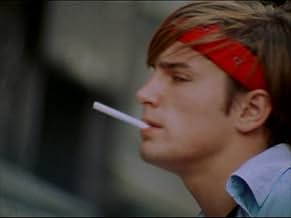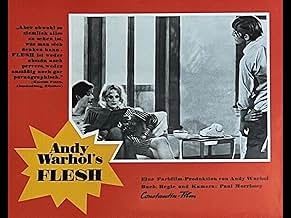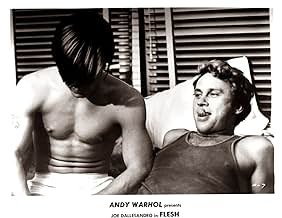NOTE IMDb
5,7/10
2,7 k
MA NOTE
Ajouter une intrigue dans votre langueA man desperate for money and no income, turns prostitute and interplays with a variety of clients and hustlers.A man desperate for money and no income, turns prostitute and interplays with a variety of clients and hustlers.A man desperate for money and no income, turns prostitute and interplays with a variety of clients and hustlers.
- Réalisation
- Scénario
- Casting principal
- Récompenses
- 1 victoire au total
Roberto D'Allesandro
- Boy in the Street #2
- (non crédité)
Jed Johnson
- Solicitor
- (non crédité)
Avis à la une
Although the film opens with the credit "Andy Warhol Presents", it was actually written, photographed and directed by cult film-maker Paul Morrissey (according to Morrissey, all Warhol provided was money and publicity).
Joe Dallesandro (immortalised as "little Joe" in the Velvet Underground song "Walk on the Wild Side") plays Joe, a slightly dim-witted male prostitute, who is supporting his bisexual wife and baby. His wife wants him to come up with $200 for her girlfriend's abortion. We basically follow Joe around as he encounters various characters willing to help him, including an artist who wants to pay him to pose nude, and Warhol "superstars" Candy darling and Jackie Curtis.
Despite being amateurishly shot, with countless technical errors, the most annoying of which is a very badly-recorded soundtrack, the film is fascinating due to it's delving into a world rarely seen on mainstream screens, which probably doesn't exist anymore. Although many scenes do go on for too long, it's too startling to be dull. Fans of Joe Dallesandro will no doubt enjoy his frequent exposure (he provides most of the flesh of the title).
If you're a fan of cult or underground films, you'll not want to miss this. It was followed by "Trash" (1970) and "Heat" (1972) to form a loose trilogy.
Joe Dallesandro (immortalised as "little Joe" in the Velvet Underground song "Walk on the Wild Side") plays Joe, a slightly dim-witted male prostitute, who is supporting his bisexual wife and baby. His wife wants him to come up with $200 for her girlfriend's abortion. We basically follow Joe around as he encounters various characters willing to help him, including an artist who wants to pay him to pose nude, and Warhol "superstars" Candy darling and Jackie Curtis.
Despite being amateurishly shot, with countless technical errors, the most annoying of which is a very badly-recorded soundtrack, the film is fascinating due to it's delving into a world rarely seen on mainstream screens, which probably doesn't exist anymore. Although many scenes do go on for too long, it's too startling to be dull. Fans of Joe Dallesandro will no doubt enjoy his frequent exposure (he provides most of the flesh of the title).
If you're a fan of cult or underground films, you'll not want to miss this. It was followed by "Trash" (1970) and "Heat" (1972) to form a loose trilogy.
In a lot of ways this film defines the essence of everything I love about cinema, in terms of capturing those strange, elusive moments of unguarded truth. In other ways, it is undeniably an amateurish, unfocused result of junkies self-indulgently fooling around with a camera. Ultimately it comes out somewhere between pure brilliance and unwatchability (thankfully much more so the former than the latter). Part of me wants to reward it solely for it's absolute innovativeness and moments of pure sublimity, but at the same time I can't completely ignore the occasionally downright awful "acting" and overtly bad production values. At first the editing seems overwhelmingly sloppy and needlessly distracting (or maybe just wrongheadedly "innovative"), but after a while I got used to it, which is, in the end, the true sign of whether a film succeeds on it's own terms or not. I guess that answer basically sums up my all-around feelings for the film. That is, despite it's in-ignorable flaws, on a whole it does work very well. And, if nothing else, a film like this really shows how false and contrived the faux-documentary, shaky-cam style can sometimes be when it so obviously applied purely for effect (such as in films like the otherwise admirable Roger Dodger). Here the aesthetics are plainly derived from the necessities of the filming situation, and are not just used arbitrarily to make it look "cool".
Flesh is the first film of a trilogy by Paul Morrissey and Andy Warhol, and is perhaps the first attempt to create an icon of desire out of a male leading role. Although the film is focused on an uncomplicated character development of Joe (Joe Dallesandro), a gentle and subtly unhappy hustler, it depicts him as a passive and ambivalent object, who, in spite of a semi-evident sense of self-control, is possessed, shaped, and evaluated entirely by others. Joe is a young and somewhat naive Adonis who exudes comfort and beauty in his independence, but he works the streets to support his lesbian wife and her girlfriend. He is restlessly bored by an artist/customer's speeches on Greek athletic sculpture and 'body worship', but he sells his nudity anyway. He regards the increasing advances of his homosexual friend with ambivalence, but lets them happen nonetheless. This passivity dominates the film and succeeds in creating a visceral element to Dallesandro's appeal: not only is he desired, he is had.
Perhaps the film's most interesting element is the balance of its obviously experimental nature with its palpable directness. The snappy editing and fragmented dialogue make it fresh and 'real', yet it manages not to rely on the clichéd abstractness of art-films. It is rough, and indeed a weaker effort than Trash or Heat, but nonetheless presents a collection of perfectly plausible characters in a light of almost absolute neutrality.
Perhaps the film's most interesting element is the balance of its obviously experimental nature with its palpable directness. The snappy editing and fragmented dialogue make it fresh and 'real', yet it manages not to rely on the clichéd abstractness of art-films. It is rough, and indeed a weaker effort than Trash or Heat, but nonetheless presents a collection of perfectly plausible characters in a light of almost absolute neutrality.
I was a junior in high school when "Flesh" hit the big screens, but had the good fortune to see it at midnight movie houses in NYC just two years later.
Flesh is the first part of a so-called "trilogy" of films, featuring Joe Dallesandro, as an object of desire. It bears the "Warhol" name, but is more the work of Paul Morissey. Essentially the story concerns itself with the exploits surrounding one day in the life of a street-wise male hustler (played by Joe Dallesandro). Joe is young, beautiful, and a bit naive... but he manages to bring home the bacon to his wife, for reasons which should not be explained to appreciate the film fully.
Of special note to film buffs is that this film (along with the remaining two of the trilogy), had no script, per se. Warhol's superstars were given simply a premise... and the words and actions which the viewer sees are quite natural (even at times ridiculous or non-sensical). But all in all it works... "Rolling Stone" noted in its review that the film was better than "Midnight Cowboy", a film of the same year, more polished by Hollywood (An Academy Award winner for Best Film) , with big name talent (I equally admire the film)... but FLESH, being improvised, was somehow more gut wrenching and realistic, without the need for complex sub-plots and any "cause de celebre" .. or for that matter any cause at all!
The film grossed more than $3 million dollars and was an absolute sensation, particularly in the German market (which, ironically, thought they were given a "censored version" of the film because of the post-editing....see note below).
Curiously, the film is very much "cut and paste" with "pops". "clicks", "flashes", and dialogue literally cut off mid-sentence. It is almost as if Warhol/Morissey are stating a simple truth that it is a "day in the life" of a superstar, snippets for your voyeuristic tendencies. Far better than earlier Warhol works of 8 hours of sleeping, and the statue of liberty as a 20+ hour movie.
FLESH, in my opinion, is the first of the Warhol films that actually is digestible (given a wide pallette) and Warhol's/the Factory's first legitimate response to the Hollywood phenomenon of "stardom".
As the first of a "trilogy", it portrays a young, desirable male icon, naive, sought after, responding to invitations to please his family. Subsequent films would show the "same character" with a differing set of values. (See "Trash" and "Heat")
Flesh is the first part of a so-called "trilogy" of films, featuring Joe Dallesandro, as an object of desire. It bears the "Warhol" name, but is more the work of Paul Morissey. Essentially the story concerns itself with the exploits surrounding one day in the life of a street-wise male hustler (played by Joe Dallesandro). Joe is young, beautiful, and a bit naive... but he manages to bring home the bacon to his wife, for reasons which should not be explained to appreciate the film fully.
Of special note to film buffs is that this film (along with the remaining two of the trilogy), had no script, per se. Warhol's superstars were given simply a premise... and the words and actions which the viewer sees are quite natural (even at times ridiculous or non-sensical). But all in all it works... "Rolling Stone" noted in its review that the film was better than "Midnight Cowboy", a film of the same year, more polished by Hollywood (An Academy Award winner for Best Film) , with big name talent (I equally admire the film)... but FLESH, being improvised, was somehow more gut wrenching and realistic, without the need for complex sub-plots and any "cause de celebre" .. or for that matter any cause at all!
The film grossed more than $3 million dollars and was an absolute sensation, particularly in the German market (which, ironically, thought they were given a "censored version" of the film because of the post-editing....see note below).
Curiously, the film is very much "cut and paste" with "pops". "clicks", "flashes", and dialogue literally cut off mid-sentence. It is almost as if Warhol/Morissey are stating a simple truth that it is a "day in the life" of a superstar, snippets for your voyeuristic tendencies. Far better than earlier Warhol works of 8 hours of sleeping, and the statue of liberty as a 20+ hour movie.
FLESH, in my opinion, is the first of the Warhol films that actually is digestible (given a wide pallette) and Warhol's/the Factory's first legitimate response to the Hollywood phenomenon of "stardom".
As the first of a "trilogy", it portrays a young, desirable male icon, naive, sought after, responding to invitations to please his family. Subsequent films would show the "same character" with a differing set of values. (See "Trash" and "Heat")
The title practically says it all, and that's all you'll need to be expecting to enjoy this movie. What you get when you watch this film is tons of the beautiful, masterpiece that is Joe Dallesandro all over the screen. It is a day in the life of his character, a married bisexual prostitute, and how his life ties in with all the people around him and all the people he does business with. It is a very interesting and well done film for how well the actors play it out. They act as if it is just an ordinary day and they don't even know a camera is filming them which makes it seem so real. Joe Dallesandro is another reason why this film works out well.
Now, I'm not saying that the main purpose was to make us want to jump into the screen, pull him out and play with him, but goodness was that boy beautiful, and I certainly wanted to do just that. It might be just for his looks that the reason we care to watch his character's day play out so much is because he's so incredibly gorgeous, but in any matter it still makes us care what happens to the character, which is something any film should try to do. It becomes an interesting tale because of how we see what amazing things he's able to do with his body and how amazing his body looks doing them, such as the Greek pose photoshoot and how him playing with and feeding his child in the nude is still sweet and charming whilst being devilishly mouthwatering.
The movie is not meant to be a landmark among film history. It's a run-of-the-mill film about an average day that is made into an excellent story and an excellent movie overall because of how much we enjoy seeing the actors and actresses take part in it. The dialog keeps your attention, the story keeps your attention and Joe Dallesandro's existence keeps your utmost attention. I suggest you see it in the right sense and you'll be able to have fun with it and enjoy it.
Now, I'm not saying that the main purpose was to make us want to jump into the screen, pull him out and play with him, but goodness was that boy beautiful, and I certainly wanted to do just that. It might be just for his looks that the reason we care to watch his character's day play out so much is because he's so incredibly gorgeous, but in any matter it still makes us care what happens to the character, which is something any film should try to do. It becomes an interesting tale because of how we see what amazing things he's able to do with his body and how amazing his body looks doing them, such as the Greek pose photoshoot and how him playing with and feeding his child in the nude is still sweet and charming whilst being devilishly mouthwatering.
The movie is not meant to be a landmark among film history. It's a run-of-the-mill film about an average day that is made into an excellent story and an excellent movie overall because of how much we enjoy seeing the actors and actresses take part in it. The dialog keeps your attention, the story keeps your attention and Joe Dallesandro's existence keeps your utmost attention. I suggest you see it in the right sense and you'll be able to have fun with it and enjoy it.
Le saviez-vous
- AnecdotesUK censor John Trevelyan was wary of issuing the film a cinema certificate and suggested to the distributors that the film be shown on a club basis. When it was initially shown at the Open Space Theatre in London in February 1970 the cinema was raided by police who attempted to seize the film, leading Trevelyan himself to hastily rush to the cinema and vigorously defend the movie against possible prosecution, calling the police action 'unjustified and preposterous'. In the light of this incident Trevelyan was able to grant the film an uncut 'X' certificate.
- GaffesDuring a scene with the go-go dancer, Candy and Jackie alternately call her by the character's first name (Terry) and that of the actress playing her (Geri Miller).
- Citations
Joe, the Hustler: How am I supposed to make any money without clean underwear?
- Crédits fousThe opening credits run sideways and list Warhol's name, the title, the main cast members, and that it was written, photographed and directed by Paul Morissey.
- ConnexionsEdited into Porn to Be Free (2016)
- Bandes originalesMakin' Wicky Wacky Down in Waikiki
Performed by Sophie Tucker.
Meilleurs choix
Connectez-vous pour évaluer et suivre la liste de favoris afin de recevoir des recommandations personnalisées
- How long is Flesh?Alimenté par Alexa
Détails
- Date de sortie
- Pays d’origine
- Langue
- Aussi connu sous le nom de
- Andy Warhol's Flesh
- Lieux de tournage
- Greenwich Village, Ville de New York, New York, États-Unis(At the apartment of critic David Bourdon)
- Société de production
- Voir plus de crédits d'entreprise sur IMDbPro
Box-office
- Budget
- 4 000 $US (estimé)
- Durée1 heure 29 minutes
- Mixage
- Rapport de forme
- 1.37 : 1
Contribuer à cette page
Suggérer une modification ou ajouter du contenu manquant















